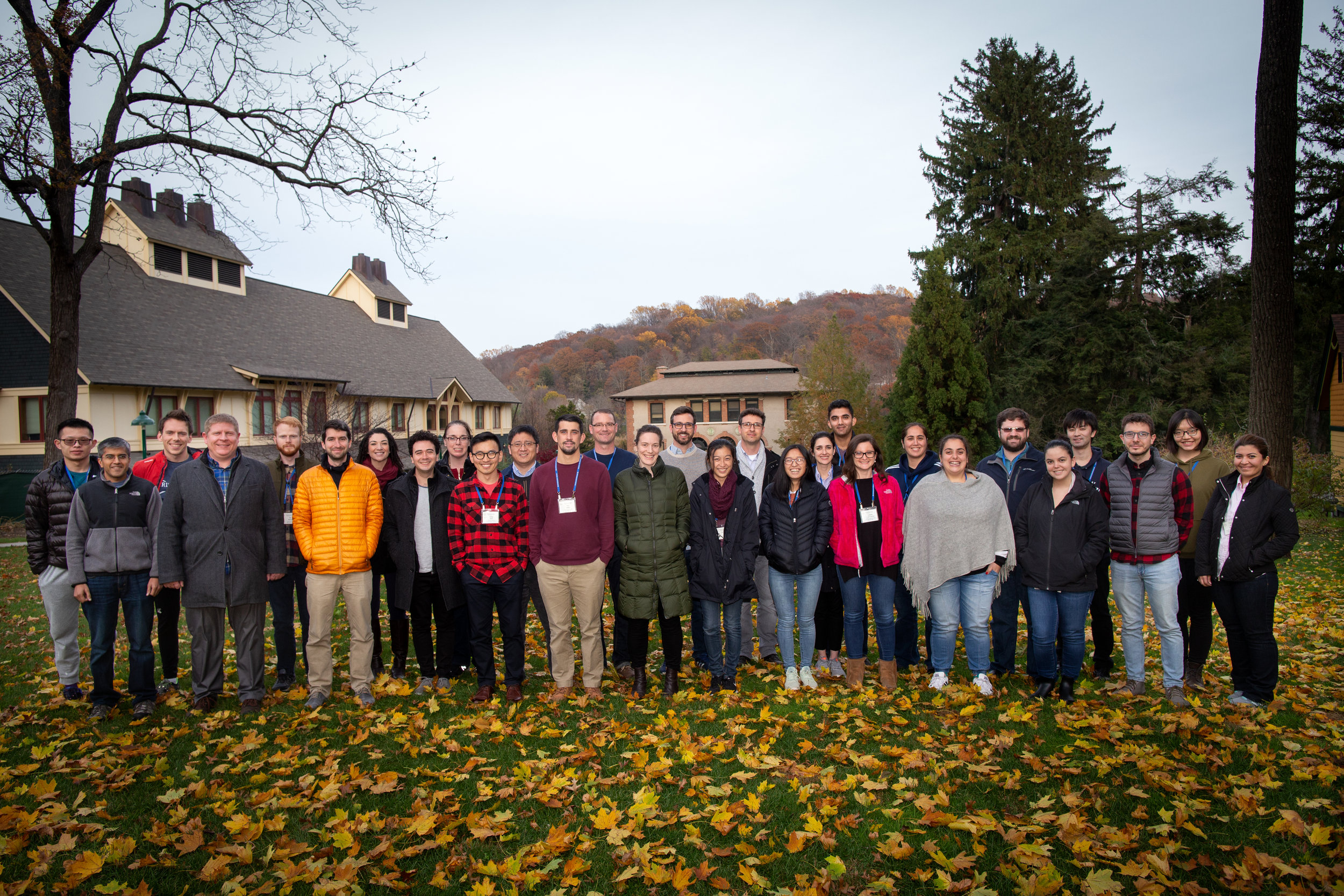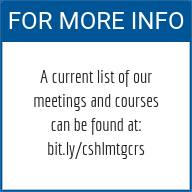Meet Diego Rodriguez Terrones of Helmholtz Zentrum München (Munich, Germany). The Mexican national is a third-year PhD student supervised by Prof. Dr. Maria-Elena Torres-Padilla from the Helmholtz Zentrum München, and Dr. Juan Manuel Vaquerizas from the Max Planck Institute of Molecular Biomedicine. Diego made his CSHL debut this year and did so with quite the “bang”: first presenting a poster at the Transposable Elements meeting then the Advanced Sequencing Technologies & Applications course less than 48 hours later. We reached out to Diego to ask him of his experiences and if there were any other CSHL meetings or courses on his radar (and we may be welcoming him again for the Mouse Development, Stem Cells & Cancer and the Synthetic Biology courses!). We began by talking about his work and how he made it the focus of his research:
In the lab, we aim to understand the molecular basis of mammalian totipotency, which is the capacity of a single cell to give rise to an entire organism. For example, in the mouse, the one cell of the 1-cell embryo and each of the two cells from the 2-cell embryo are the only three totipotent cells that occur during development. What this essentially means is that if you let a 1-cell embryo develop to term you will get one mouse, and if you split up the 2 cells from the 2-cell embryo and let them develop independently, you will get two twin mice. Once the two cells from the 2-cell stage embryo divide once more to form the 4-cell stage embryo, totipotency is lost and it won’t be possible to initiate development from a single cell ever again during this round of development! Our goal is to understand what makes this particular set of three cells stand out from all others; specifically how the unique epigenetic landscape that arises at the beginning of development mediates this unique totipotent capacity.
Early on in my career, I realized that my main interests laid within the field of synthetic biology and that my long-term goal was to enable the engineering of biological systems that possess properties or exhibit behaviors not found in nature. However, I also understood at the time that any attempt to engineer life would most certainly fail without a thorough understanding of gene regulation, and all the epigenomic mechanisms that translate one unique genotype into the multitude of cellular phenotypes that exist throughout an organism. Under that logic, what better place to start than the early embryo where the mammalian developmental program and its epigenome are kick-started.
How did your scientific journey begin?
Actually, as far back as I can remember I’ve always wanted to be a scientist! When I was around 5 years old, for some reason, I started watching a lot of astronomy documentaries on TV and became absolutely fascinated by the idea of space exploration. Over the course of the next several years, however, I think I started to understand just how difficult space exploration really was, how little we were doing it, and just how much our biological limitations stood in the way of making space exploration a reality. Mainly because of this, and by the age of 12, I remember having had decided that I wanted to pursue a career in something involving biology or medicine, and was what eventually led me to start a career in genomics during my undergrad.
You recently joined the 200+ alumni of the Advanced Sequencing Technologies & Applications course. What attracted you to the course and what did you take away from it?
I was particularly interested in learning about the new long read sequencing technologies, and about genome assembly and the analysis of structural variants. These two topics were indeed two of the course’s central themes this year, so it was quite productive for me! I think it’s a fantastic course for primarily developing your bioinformatic skills, targeted towards the very latest technologies. I’m happy to have acquired a rather wide collection of new experimental and bioinformatic skills during this course, ranging from variant calling and genome assembly, all the way up to the preparation of single-cell RNA-seq libraries with 10X genomics. I’m in the process of incorporating the training in the analysis of RNA-seq data that I acquired at the course towards my current research project. If anything, I guess my key takeaway from this course -- of this year -- is that long read sequencing technologies are revolutionizing genomics! I think both beginner and intermediate bioinformatic users would benefit from the course equally, which is rather unusual for a course like this and speaks highly about its quality.
This year, you also attended the Transposable Elements meeting. Can you tell us what led you to register for this meeting in particular?
Since I will be finishing my PhD relatively soon, I wanted to see where the field was heading and gather some ideas for my postdoctoral project. As a matter of fact, quite a few of the things that I learnt during the meeting are going to shape what I end up doing during my postdoc. This meeting represents ones of the best opportunities to get a global overview of the transposon field; so if you are working on repetitive elements, I would most definitely recommend it. Another group that I think would greatly benefit from it is anyone working on molecular biology or -omics method development: there are so many crazy molecular mechanisms going on with transposons that I think it would be rather inspiring!
One key takeaway was very neatly put forward by Cedric Feschotte during his keynote when he argued that the genome can only be understood as an ecosystem. I think this concept very elegantly puts together the idea that genomes are teeming with all sorts of selfish genetic entities that range from DNA transposon and endogenous retroviruses, all the way to parasitic repetitive elements that exploit other transposable elements for their own replication. However, the key point here is that while this interplay between host genome and transposable elements can give rise to genetic conflicts, it can also result in selective advantages to the host organism by providing a continuous source of novel regulatory sequences and even of novel regulatory proteins.
Since you’ve now experienced both meeting and course life at CSHL, did you pick up any differences or similarities between the two function types?
Well, long hours are definitely a constant between both!
What did you like most about your time at CSHL?
The course materials are perhaps my favorite general thing. They are of exceptional quality and permit us to come back to them for further reference once we start applying what we learnt! Also, the instructors were great, and it was really easy to approach them to discuss how to best address the specific challenges we are encountering in our own projects.
During the meeting, I really enjoyed the poster session. The quality of the posters were remarkable and there were tons of posters I was extremely interested in visiting! Fortunately, there was also a lot of time to mingle around during the poster session which is definitely not the case at every meeting). Also, the keynotes were spectacular!
Thank you to Diego for sharing with us his experience, and we look forward to having him back at the Laboratory again for the two courses he has his sights set on - Mouse Development, Stem Cells & Cancer and Synthetic Biology. Both annual courses are accepting applications until March 1, 2019 and April 1, 2019, respectively. The Advanced Sequencing Technologies & Applications course will again be offered at CSHL from November 5-17, 2019 (with applications due here by July 15, 2019); and the Transposable Elements meeting will return in October 2020.
Also, we would like to particularly thank Prof. Torres-Padilla, his institutions, HELENA (Helmholtz Graduate School Environmental Health), and Chromatin Dynamics (Integrated Research Training Group IRTG-SFB 1064) for providing Diego with the financial support that enabled him to participate at his CSHL meetings and courses this year.
To meet other featured scientists - and discover the wide range of science that takes part in a CSHL meeting or course - go here and here.






















